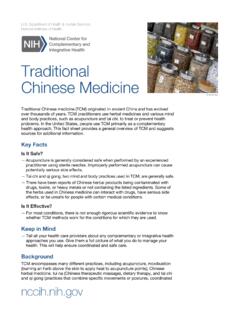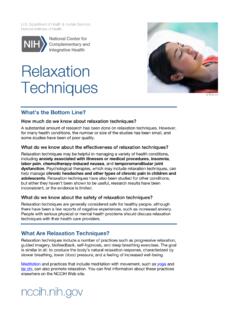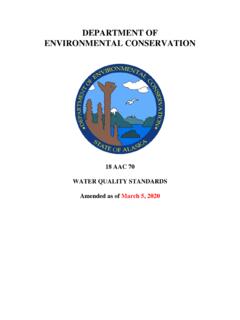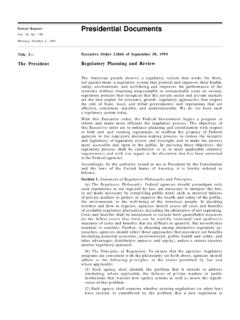Transcription of The Use of Complementary and Alternative Medicine
1 The Use of Complementary and Alternative Medicine in the United StatesAbout CAMCAM is a group of diverse medical and health care systems, practices, and prod-ucts that are not generally considered part of conventional Medicine . Complementary Medicine is used together with conven-tional Medicine , and Alternative Medicine is used in place of conventional Medicine . Integrative Medicine combines conven-tional and CAM treatments for which there is evidence of safety and effectiveness. While scientific evidence exists regarding some CAM therapies, for most there are key questions that are yet to be answered through well-designed scientific studies questions such as whether these therapies are safe and whether they work for the purposes for which they are used. NCCAM s mission is to explore CAM practices using rigorous scientific methods and build an evidence base for the safety and effective-ness of these practices. How Many People Use CAMIn the United States, approximately 38 percent of adults (about 4 in 10) and approximately 12 percent of children (about 1 in 9) are using some form of CAM, shown in figure 1.
2 1 Unless noted otherwise, the statistics are for CAM use during the 12 months prior to the 2007 survey. Comparisons from the 2002 NHIS are 1 CAM Use by Adults and ChildrenAdults(2007)Adults(2002)Children (2007)In December 2008, the National Center for Complementary and Alternative Medicine (NCCAM) and the National Center for Health Statistics (part of the Centers for Disease Control and Prevention) released new findings on Americans use of Complementary and Alternative Medicine (CAM). The findings are from the 2007 National Health Interview Survey (NHIS), an annual in-person survey of Americans regarding their health- and illness-related experiences. The CAM section gathered information on 23,393 adults aged 18 years or older and 9,417 children aged 17 years and under. A similar CAM section was included in the 2002 NHIS, providing the opportunity to examine trends in CAM use, Institutes of HealthNatioNal CeNter for Complementary aNd Alternative mediCiNeAcupuncture* Ayurveda* Biofeedback* Chelation therapy* Chiropractic or osteopathic manipulation* Deep breathing exercises Diet-based therapies Energy healing therapy/Reiki*Guided imageryHomeopathic treatmentHypnosis*Massage*MeditationMove ment therapiesNatural products (nonvitamin and non- mineral, such as herbs and other products from plants, enzymes, etc.)
3 Naturopathy*Progressive relaxationQi gongTai chiTraditional healers*YogaFigure 3 CAM Use by Race/Ethnicity Among Adults - Indian/ alaska Therapies Included in the 2007 NHIS: An asterisk (*) indicates a practitioner-based therapy. For definitions of these therapies, see the full report or contact the NCCAM Clearinghouse (see page 4). 2 The Use of Complementary and Alternative Medicine in the United StatesWho Uses CAM Most People of all backgrounds use CAM. However, CAM use among adults is greater among women and those with higher levels of education and higher incomes. Figure 2 shows the percentage of people using CAM by age. Figure 3 shows CAM use by race/ethnicity. CAM Therapies Used the MostNonvitamin, nonmineral natural products are the most commonly used CAM therapy among adults. Use has increased for several therapies, including deep breathing exercises, meditation, massage therapy, and yoga. Figure 4 shows the percentage of people using the most common CAM therapies and therapies with significant increases between 2002 and of Natural Products The most popular natural products are fish oil/omega 3, glucosamine, echinacea, and flaxseed.
4 Figure 5 ranks the top 10 natural products used among adults in 2007 and 2002 (note that the 2007 survey asked about use in the last 30 days, whereas the 2002 survey asked about use in the last year). Health Conditions Prompting CAM Use People use CAM for an array of diseases and conditions. American adults are most likely to use CAM for musculoskeletal problems such as back, neck, or joint pain. The use of CAM therapies for head or chest colds showed a substantial decrease from 2002 to 2007. Figure 6 ranks the top 10 conditions prompting CAM use among adults for 2007 and 2 CAM Use by Age - 85+Figure 5 10 Most Common Natural Products Among AdultsBack PainBack PainNeck PainNeck PainJoint PainJoint PainArthritisArthritisInsomniaAnxietyAnx iety/DepressionStomach UpsetRecurring PainInsommiaCholesterolHead or Chest ColdHead or Chest ColdOther MusculoskeletalSevere Headache or MigraineSevere Headache or MigraineFish Oil/Omega 3 Fish Oil/Omega 3 GlucosamineGlucosamineSt.
5 John s WortPeppermintEchinaceaEchinaceaGinsengG insengGinkgo BilobaGinkgo BilobaGarlic SupplementsGarlic SupplementsFlaxseed Oil/PillsCombinationHerb PillsChondroitinCoenzyme Q-10 Soy 6 Diseases/Conditions for Which CAM Is Most Frequently Used Among Adults The National Center for Complementary and Alternative Medicine 32007*2007 2002*2002*Percentages among adults who used natural products in the last 30 days.*Percentages among adults who used natural products in the last 12 4 10 Most Common CAM Therapies Among Adults - 2007 Natural & with significant increases between 2002 and 2007 are 2002 2007 Deep breathing 7 10 Most Common Therapies Among ChildrenFigure 8 Most Common Natural Products Among Children*Figure 9 Diseases/Conditions for Which CAM Is Most Frequently Used Among ChildrenNatural ProductsDeep BreathingEchinacea*Percentages among children who used natural products in the last 30 PainHomeopathic TreatmentFish Oil/Omega 3 CombinationHerb PillsFlaxseed Oil/PillsInsomniaADHDO ther MusculoskeletalMassageAnxiety/Stress Head or Chest ColdYogaTraditional HealersMeditationProgressive RelaxationDiet-Based Use Among ChildrenThe 2007 NHIS asked selected adult respondents about CAM use by children in their households.
6 Overall, approximately 12 percent of children use some form of CAM. Use is greater among: Children whose parents used CAM ( ) Adolescents aged 12-17 ( ), compared to younger children White children ( ), compared to Hispanic children ( ) and black children ( ) Children whose parents had higher education levels (more than high school: ) Children with six or more health conditions ( ) Children whose families delayed conventional care because of cost ( )Figures 7-9 show survey findings on CAM use by children, including top therapies, natural products, and NCCAMNCCAM s mission is to explore Complementary and Alternative healing practices in the context of rigorous science, train CAM researchers, and disseminate authoritative information to the public and Obtain the ReportThe report s citation is Barnes PM, Bloom B, Nahin R. CDC National Health Statistics Report #12. Complementary and Alternative Medicine Use Among Adults and Children: United States, 2007.
7 December 2008. It is available, along with a press release and graphics, at People who do not have access to the Internet can contact the NCCAM Clearinghouse (see below) for a MORe INFORMATIONNCCAM ClearinghouseThe NCCAM Clearinghouse provides information on CAM and NCCAM, including publications and searches of Federal databases of scientific and medical literature. The Clearinghouse does not provide medical advice, treatment recommendations, or referrals to in the : 1-888-644-6226 TTY (for deaf and hard-of-hearing callers): 1-866-464-3615 Web site: E-mail: The Use of Complementary and Alternative Medicine in the United StatesCreated December 2008 DePartmeNt of HealtH aND HUmaN ServIceSNational Institutes of HealthNational center for Complementary and Alternative medicineAddITIONAl RePORTSNCCAM plans to collaborate with NCHS on further analyses of the survey findings. Among the areas of interest to the researchers are CAM costs and spending, dietary supplements, and reasons for CAM use.
8 Future reports will be published by NCHS and posted on the NCCAM web site.*D424* Chiropractic & Osteopathic












